SketchUp’s much-anticipated, native Revit Importer headlined our 2023 Studio update. Now that you’ve had some time to test it out, use these six tips to step up your Revit to SketchUp workflow and save yourself — and your project team — hours or even days.
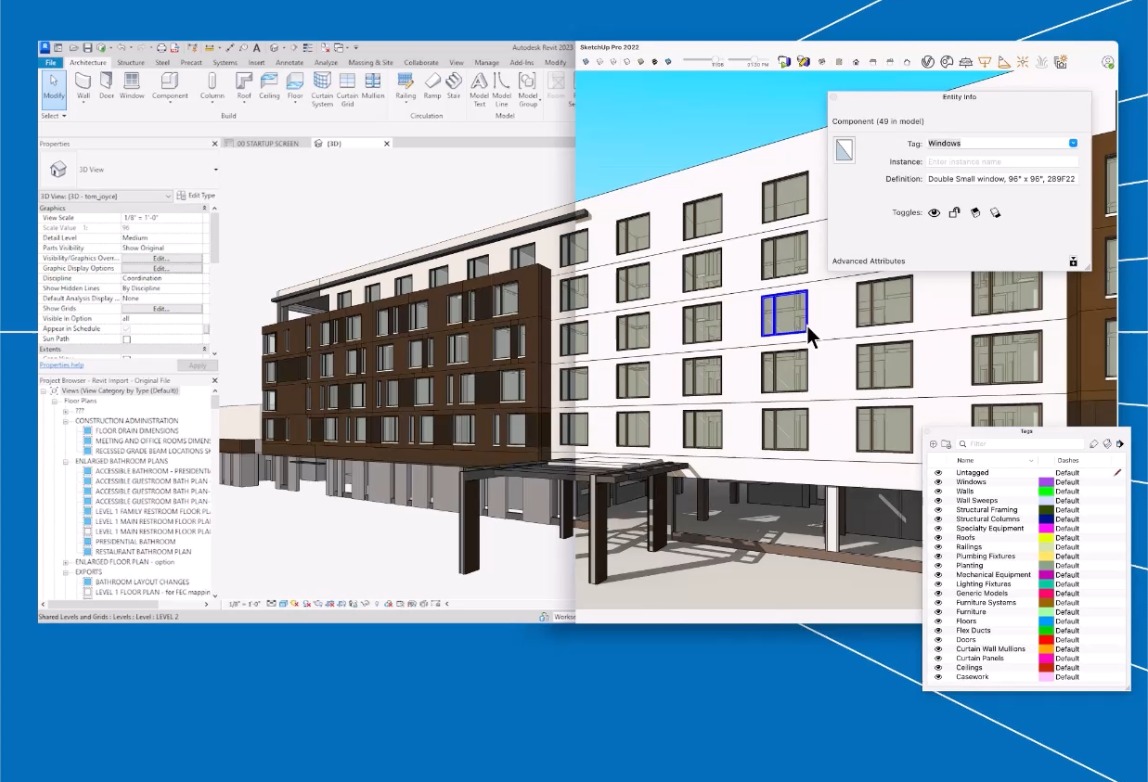
Spread the word — SketchUp’s Studio subscription now includes an all-new, native Revit Importer. We’re energized by the excitement and feedback we’ve heard from the SketchUp community since the official launch in February. The tips and tricks below will streamline your workflow from Revit to SketchUp and back again.
The Revit Importer needs no introduction. Much like it sounds, the importer brings Revit models into SketchUp, converting families and building elements to SketchUp’s native tags and components. It optimizes geometry, creating a lightweight and well-organized SketchUp file that’s ready to use. What’s most exciting is the importer empowers everyone in the AEC industry — not just architects and high-powered Revit users — to very easily bring Revit files into SketchUp at any stage of the design.
Before we get to the workflow tips, let’s highlight just a few key scenarios where moving from Revit to SketchUp makes sense. These are the moments where the importer really shines.
In all but the most idyllic of projects, you may come to a point where a design choice doesn’t work exactly as envisioned. Of course, there’s always a deadline, so you need to model and study alternate solutions quickly. SketchUp excels when it comes to conceptualizing and communicating ideas. Jump into SketchUp to make design decisions faster without committing to hours of detailed work in Revit.
Even on the best days, complex geometry can be difficult to build and manipulate in Revit. Import your latest model into SketchUp to add new geometry that might otherwise be too time-consuming to build natively in Revit. 3D Warehouse, a library of millions of pre-built SketchUp models, speeds up your workflow and lets you explore 3D models that Revit doesn’t typically handle, like specific furniture from real-life brands, plants and landscape features, or specialty equipment.
SketchUp’s widespread use across the AEC industry means that the majority of your project partners are familiar with it — and if not, its intuitive tools are easy to pick up. Landscape architects need the latest 3D model to design accurate site context (not to mention SketchUp is great for showing trees and vegetation). General contractors may use SketchUp models for phased workflow planning. For project stakeholders that don’t work in Revit, the importer enables you to widely share up-to-date 3D models with minimal effort.
Take your imported 3D model on-site using SketchUp for iPad, available in all SketchUp subscriptions. Open the model on your iPad for mobile walkthroughs, and use augmented reality to take stakeholders on a virtual tour of their soon-to-be project while you’re on the job site. Lightweight SketchUp models plus iPad make on-the-go show-and-tell easy.
SketchUp helps you more effectively ideate and communicate at any stage of the design process. With no shortage of ways the Revit Importer can both simplify and expedite your workflow — not to mention the ease of the import — you’ll be on the lookout for any excuse to jump into SketchUp.
Subscribed to Go or Pro, but not Studio? Take a look at these three interoperability tips for other ways to move from Revit to SketchUp.
With a little pre-planning and a few considerations, you can seamlessly transition from Revit to SketchUp.
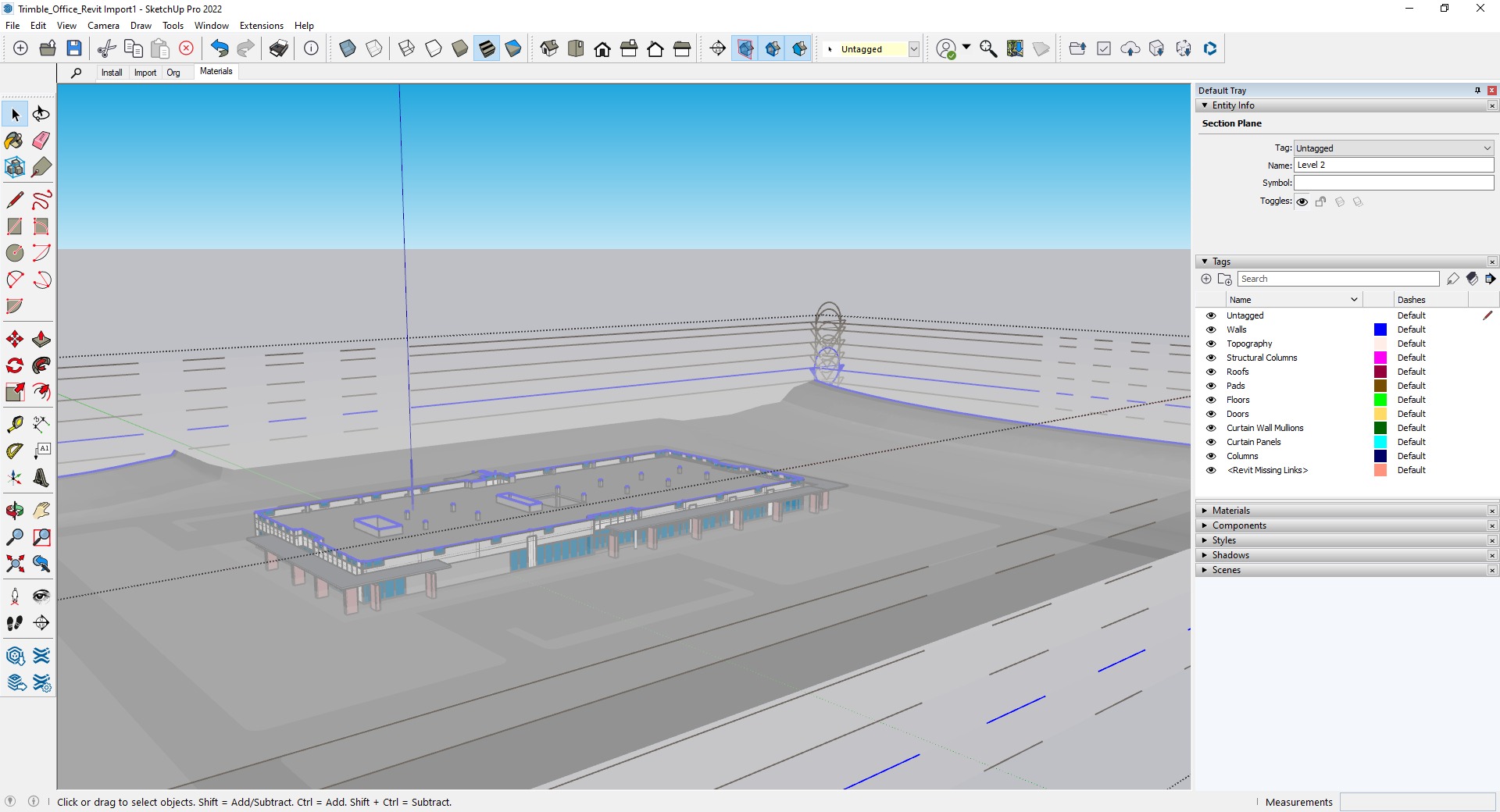
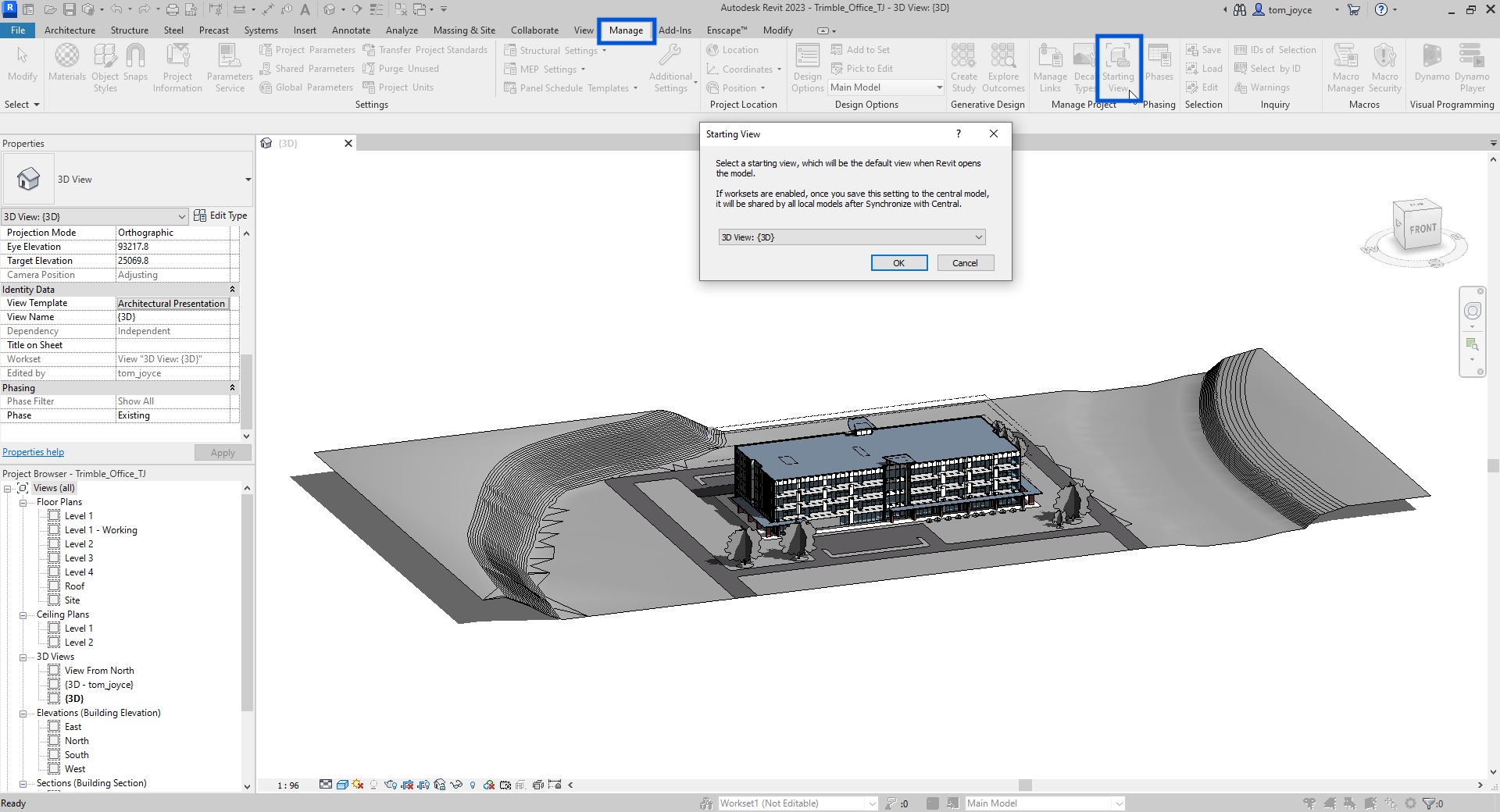
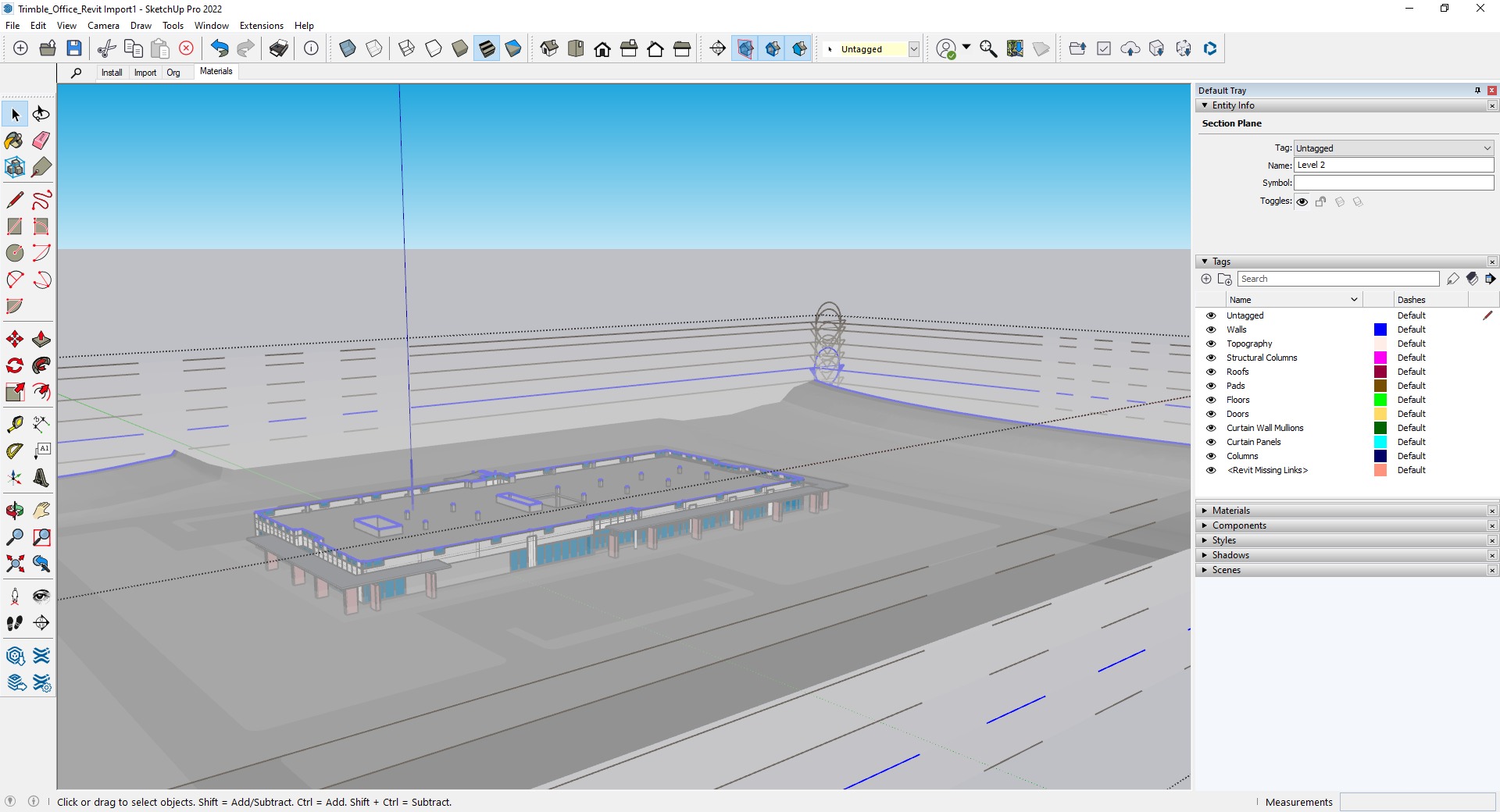
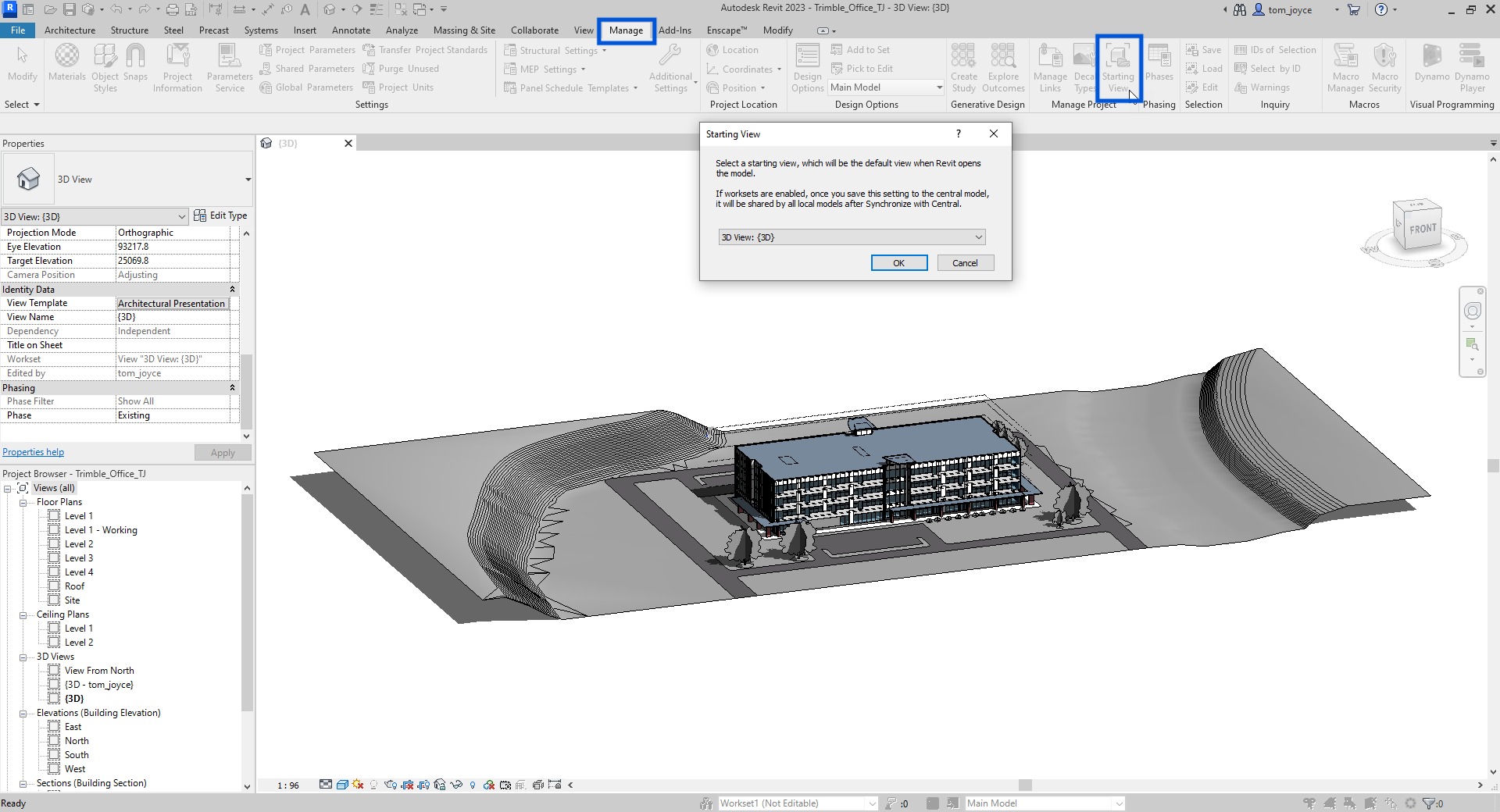

Revit starting view and levels translated to sections in SketchUp — some of the importer’s default logic
Understanding the Revit Importer’s default behavior lets you know what to expect in SketchUp. You can control which elements are imported into SketchUp using view templates, graphic overrides, and hide/unhide in Revit. These are the basics of the default import logic.
Simply put, we designed the importer to create an immediately usable SketchUp model. It’s as though you built it — and organized it really well — natively in SketchUp. No surprises!
For a more technical dive into the ins and outs of the Revit Importer, check out the Revit to SketchUp help article.
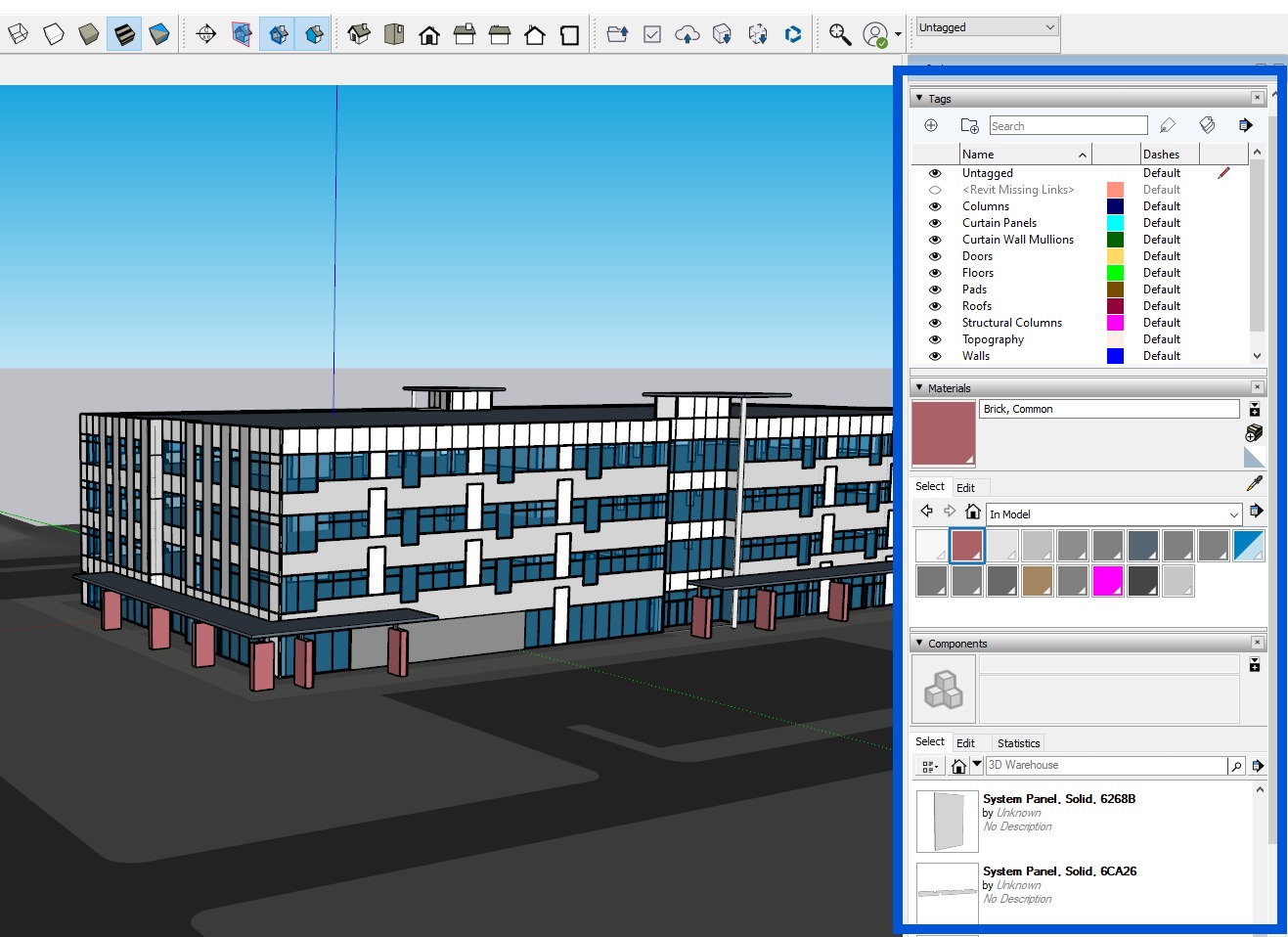
Minimize the number of unique elements, materials, and tags to keep models lighter weight and easy to navigate.
What’s good for modeling is typically good for construction. Keep a clean, well-organized Revit file with as few materials and unique families as possible. Before importing, double-check your Revit model. Clean up unnecessary model elements so you don’t end up with unwanted tags, colors, and data bogging down your SketchUp model. You wouldn’t use 50 window types if you can get away with four or five. In SketchUp, this equates to a better-organized, lighter-weight, more usable file. In construction, it means simplified planning, reduced cost, and more efficient installs.
This clean-model thinking applies to sharing models with consultants too. Landscape architects may only need the building exterior so they can add site context around it — no need to bring in MEP fixtures, HVAC equipment, furniture, etc. Hide those elements in Revit before the import for a more optimized SketchUp file.
Construction projects often include phases that dictate what work should happen and when. Phases aren’t a standalone feature in SketchUp, but preserving and sharing your Revit phases using Tags is simple.
Preserving phases from Revit to SketchUp
The goal here is to separate phases in Revit and bring each in with its own import. Importing each phase without any other geometry will turn that entire phase into a single component. You can then tag it with the name of the phase and hide or show it as needed. Here’s the breakdown.
With a little pre-planning, parse out your imports to bring in phases and tag them so you can toggle them off and on independently. If your Revit model is organized, it likely will have taken you longer to read this section than it will to import your next phase!
The importer gives you a solid foundation for materials. It converts interior and exterior finishes from Revit to solid colors in SketchUp and supports transparent materials. If you’re familiar with Revit, the colors in SketchUp match the appearance of the consistent colors option. Depending on your style, you may want to add textures or swap in specific materials.
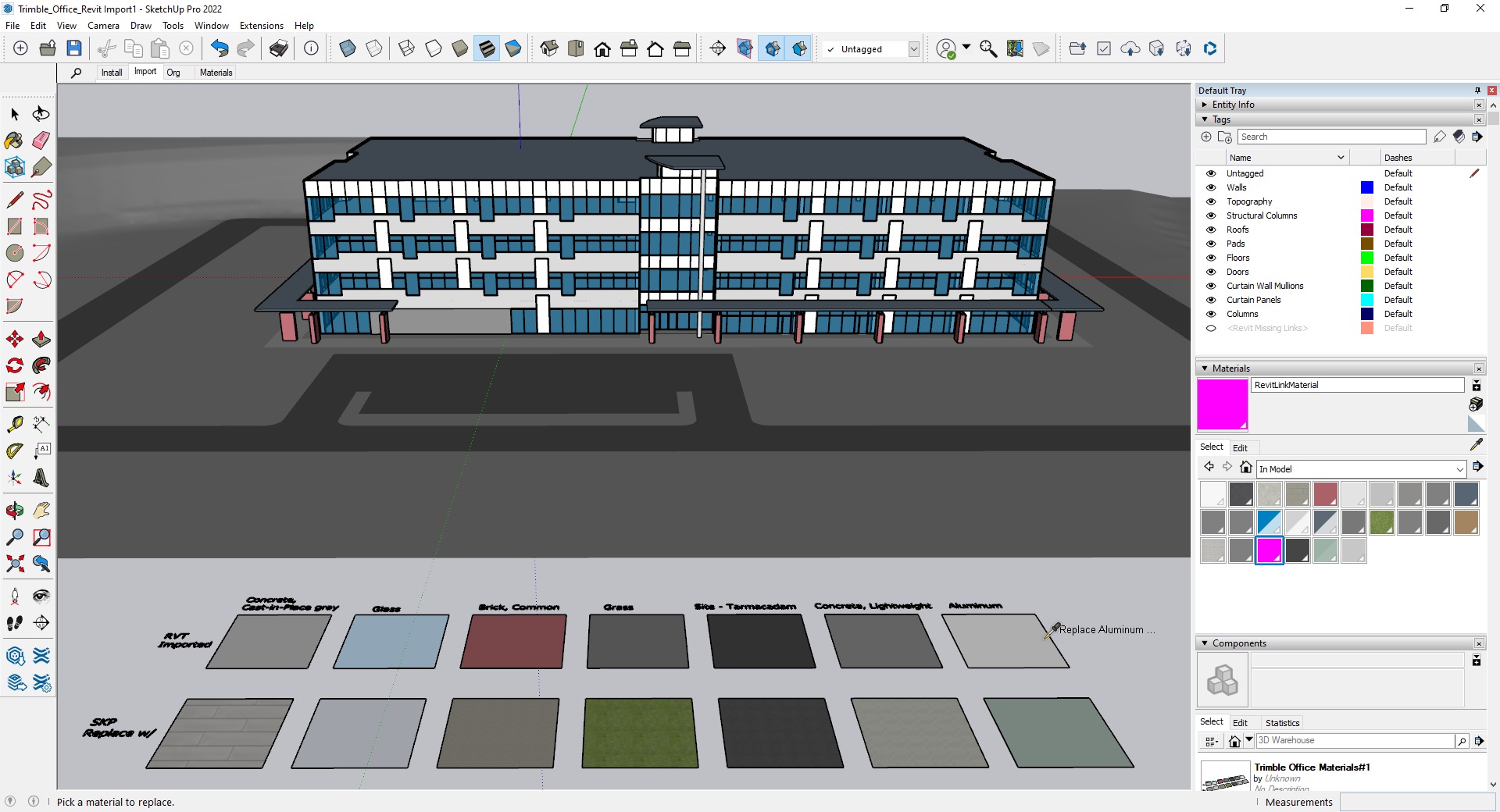
Create a material palette to quickly replace colors from Revit with SketchUp’s native materials.
With the free Material Replacer extension by Thom Thom, quickly replace those defaults with your SketchUp materials in just a couple of clicks.
This extension can be used when first importing a model into SketchUp and is helpful when re-importing an updated Revit model. The model will revert back to those default colors each time you import. If you’ve already specified your materials in SketchUp, they’re saved in the model for you. Now it’s just a matter of clicking one instance of the color to replace and one instance of the material you want.
Pro tip: create a material palette when you first import your Revit model. This can be as simple as two rows of squares, one with the material you want to use and one with the corresponding colors from Revit. No need to search around the model for each material; you’ve got everything you need right next to each other. You’ll notice as you replace materials, the defaults within the palette are also replaced. You can preserve the palette for future use by saving it in a different file or as a component in another file. With each new import, just copy the palette back into the model to reuse.
Scenes in SketchUp let you or anyone you’re sharing a file with click a single button to move to a pre-saved view of your model. Once you save scenes, any level of SketchUp user can quickly navigate your model and see exactly what you need them to see.
When you import an updated Revit model into a file you’ve already spent time on, the last thing you want to worry about is updating every scene. Avoid this tedious task by making sure the new model is perfectly aligned with the old one. You can take a few routes to ensure updated models or individual components align perfectly with the original.
Don’t move the model: the importer defaults to the same location based on the model origin. Before importing, delete the parts of the old model you want to replace (maybe you just want the building from Revit, but the site context built in SketchUp is good to go) so you don’t end up with two models sitting on top of one another. Run the importer, and the new model will populate in the same spot as the old one.
These next two options are different variations on replacing a component. Re-import all or part of your Revit model into the SketchUp file you’ve already created. Both are helpful if you’ve moved parts of the model and when sharing models with consultants. Use the fact that the importer converts geometry into components to your advantage to easily swap old for new.
“Replace selected”
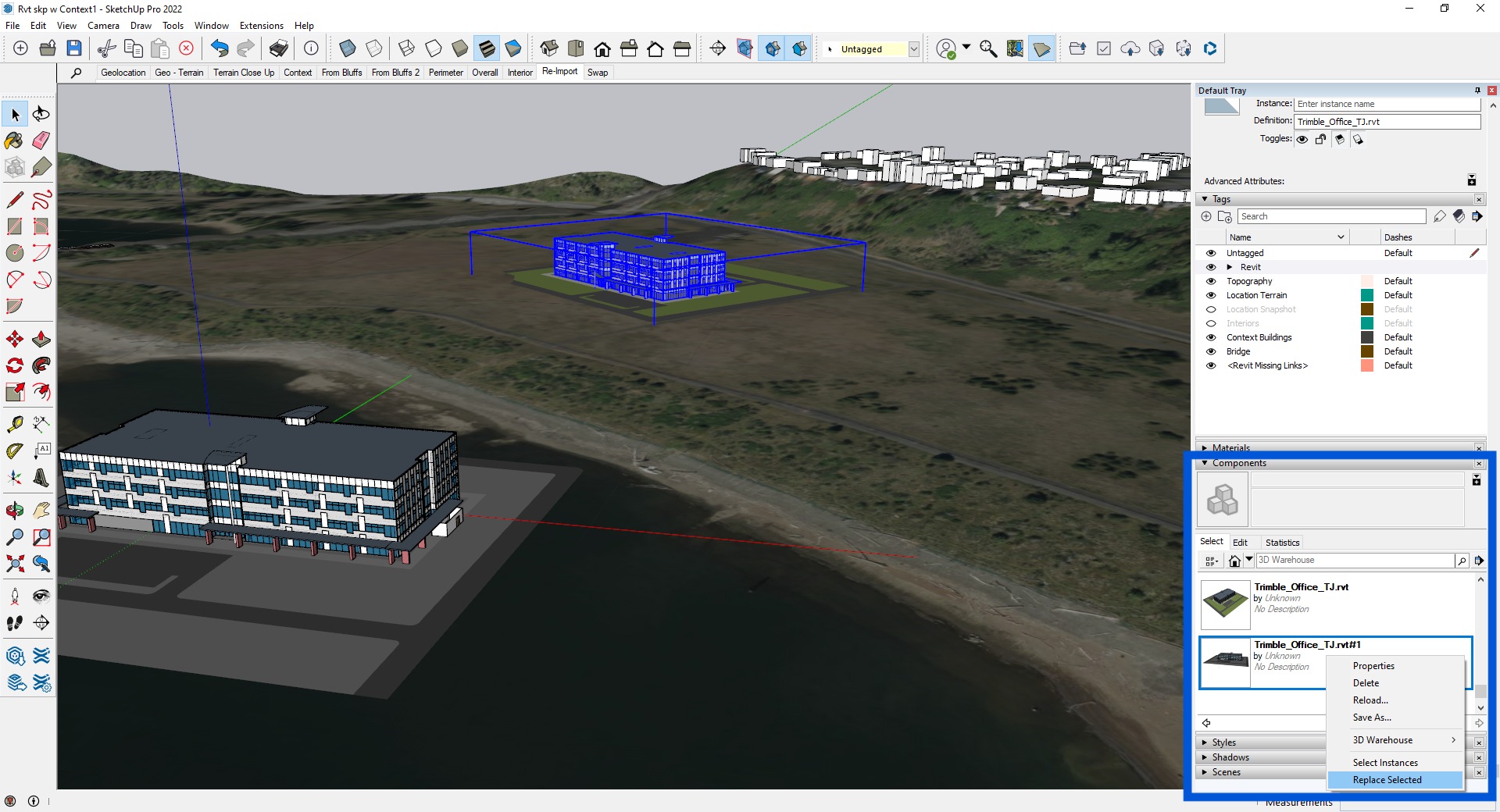
‘Replace selected’ component to easily place an updated component in the same location.
Let’s say you have an updated structural model from your engineer. Use the importer to bring just the updated structure into your SketchUp model. It will come in as a new component.
Pro tip: this workflow will create duplicate components in your file. Even though you delete the old component from the model, SketchUp saves it in the file so you can use it later. Use the “Purge unused” command to delete the duplicate permanently. “Purge unused” will also remove unused materials and styles and is a great habit to get into to keep your file size down and ensure files are as clean as possible before sharing. From the “Window” dropdown, open “Model Info” to find the “Purge unused” button.
"Reload"

‘Reload’ achieves the same goal as ‘Replace selected’ without creating a duplicate component in your model.
Reload quickly replaces all instances of the selected component with a new version. It’s handy for replacing furniture, windows, plantings, etc. — anything repeated in the model where you want to replace every instance. Reloading avoids duplicate components in your model and speeds up processing time by not importing a new component into an already large SketchUp file. We’ll use the same example from above.
Pro tip: to make some friends on your project team, share the “reload” workflow. Send consultants just the smaller, updated component files instead of the entire model. With the updated component file, they can select the old component in the SketchUp file they’re already working on, hit “Reload,” and replace the old with the new without even opening the updated file you shared. Save them the copy-and-paste and the duplicate components, and you’ll be the MVP.
After making design decisions based on your SketchUp model, you likely want to go back to Revit to update a construction documentation (CD) set or finalize permit documentation. People often don’t realize you can bring SketchUp files directly into Revit by linking or importing them. From the “Insert” tab, use the “Link CAD” or “Import CAD” functions. It’s worth noting that you’ll need to have the file type in the dialog set to SketchUp files. The default is CAD file types, so you may not initially see your SketchUp file as an option.
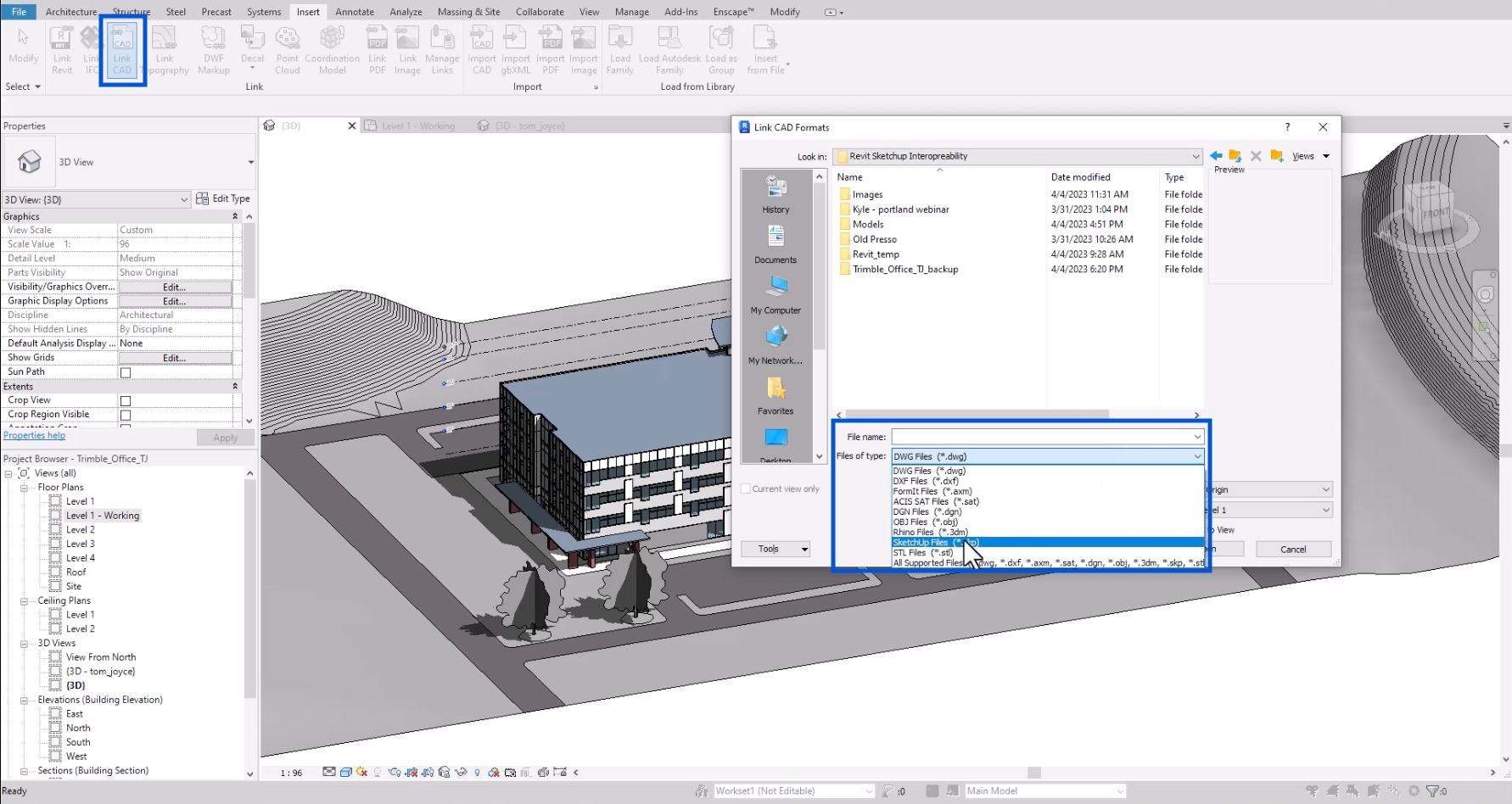
The Link CAD tools in Revit provide a handful of ways to bring SketchUp models back into Revit
Note: if the SketchUp model shows up in Revit at unexpected locations, you may need to play with the “Positioning” and “Place at” controls in the insert menus.
The Revit Importer makes it easy to pop in and out of SketchUp at any point in the design process, so you can quickly take your visualization and communication further. And now that it’s easy to move into SketchUp, take advantage of the wider Trimble ecosystem and other SketchUp integrations. Included with your subscription are a handful of Trimble tools that unlock new potential for your SketchUp model.
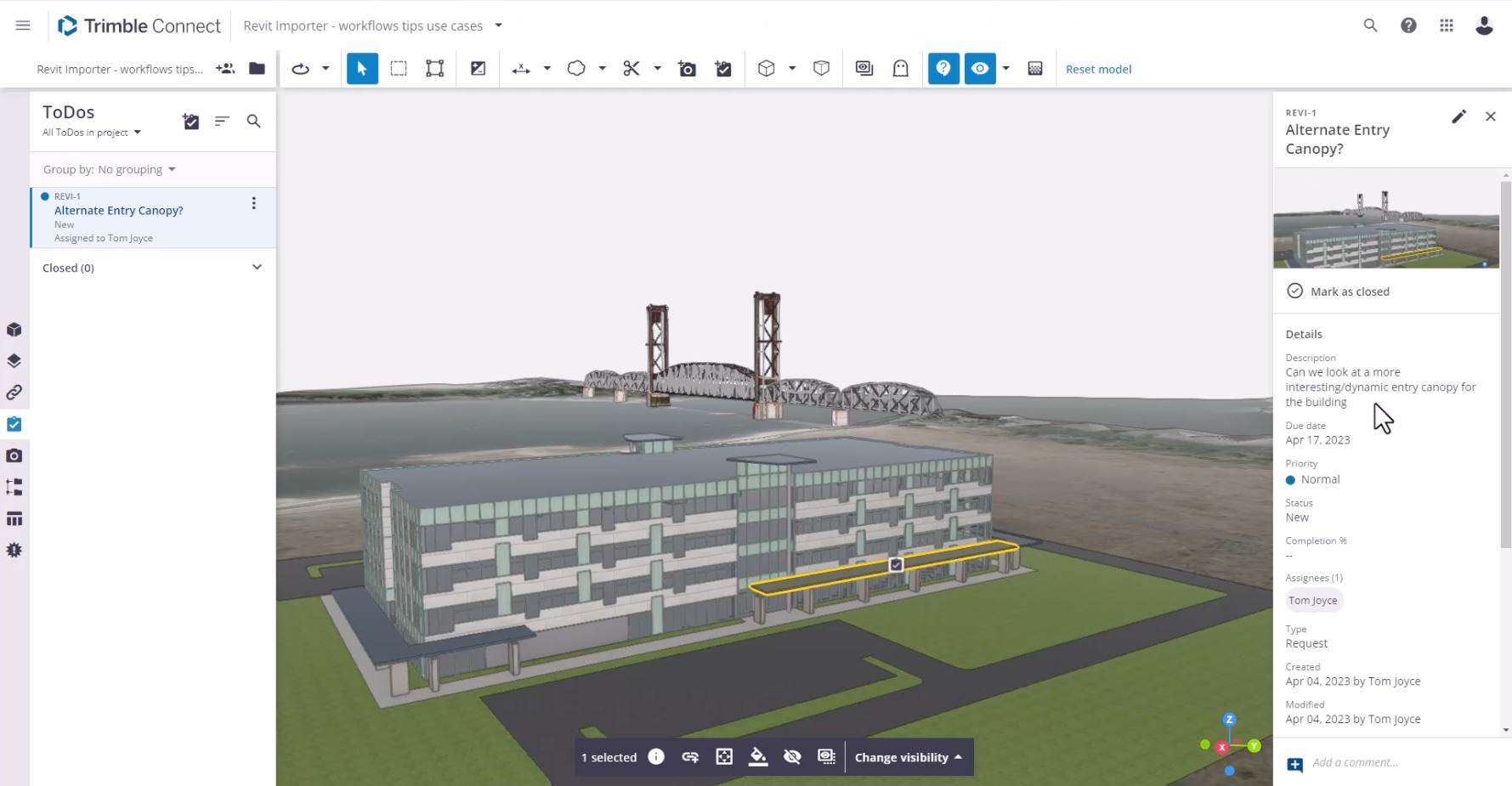
Use Trimble Connect to share models, gather feedback, and collaborate.
Powered by Froala Editor
Subscribe to receive blog updates using your address.